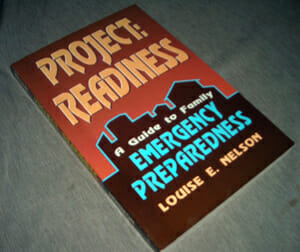Reviewed by: Sondra Wollbrinck
www.mom7x.blogspot.com
 Louise Nelson took everything into consideration in 1974 when she wrote this wonderful book. Don’t let the subject matter overwhelm you. She’ll walk you through being prepared so you won’t be in a panic when a time of crisis does occur. She takes every aspect of preparedness into consideration—Emergency and Disaster Planning, Food Storage, Storing Non-Food Items, and Other Aspects of Emergency Preparation.
Louise Nelson took everything into consideration in 1974 when she wrote this wonderful book. Don’t let the subject matter overwhelm you. She’ll walk you through being prepared so you won’t be in a panic when a time of crisis does occur. She takes every aspect of preparedness into consideration—Emergency and Disaster Planning, Food Storage, Storing Non-Food Items, and Other Aspects of Emergency Preparation.
“We live in an interdependent society. This makes us very vulnerable in hard times and in times of emergency or disaster.” We can see this as we watch the coverage of the wars and natural disasters that are happening around the world today. If for some reason, our supply chain is interrupted, would you be prepared to take care of yourself and your family? Ms. Nelson ties it all together, and if you follow her suggestions, you will have a plan of action for any type of emergency.
EMERGENCY AND DISASTER PLANNING
There is an excellent description of the phases of disaster and what to expect as a disaster develops. “People tend to disregard the threat of disaster. There is a natural human protective mechanism that gives man a sense of invincibility.” As we’ve seen in Japan (3/2011), no one, no matter their economic status, is left untouched by disaster, natural or man-made. Ms. Nelson covers the top 10 disasters and what’s necessary to successfully survive.
FOOD STORAGE
“The idea of a home storehouse is not new. For most of us it is a relic of bygone days.” Several lists are given to help guide you to create a storehouse that fits your family. Follow these guidelines and you’ll be surprised how quickly it will come together. “The primary rule of food storage is: STORE WHAT YOU USE AND USE WHAT YOU STORE.”
You will need a cool, dry, and dark area for your storage; extreme changes in temperature will affect the usability of the foods. Don’t freeze foods that haven’t been prepared for freezing; freezer-burn will make the food unpalatable. Moisture can rust cans, and cloth or paper containers will mold or rot. There is a very nice illustration for shelves for canned good storage; this will make for easy rotation. There are several places you can obtain storage items. Do your research now, find the best deals, and don’t forget about local farmers markets and wholesale clubs.
Making sure you keep track of your inventory is very important. “Make a card or cards for each food or category of foods, for example: vegetables, meats, non-food items, wheat.” Track your purchases and usage on these cards; you will see your eating patterns and know what to buy. There are also 27 pages on how to store just about every type of food. Don’t forget about water storage. Ms. Nelson hasn’t, with sections on sources of water, how to store water, and water purification. This is very helpful.
 There are several ways to preserve food. You just have to consider which way is best for each type of food. She gives very detailed instructions on each technique. Do you know how to tell if your food is spoiled? If not, you will after reading Chapter 11. One other consideration for your storage is pest control. Proper preservation and storage will keep your food pest-free. Reading over this section will be crucial to keeping your food safe. There are also 42 pages on how to use what you have stored; recipes, cooking charts and tables, a substitution list and menu plan. You won’t have to have to eat the same meals every week, and there are lots of surprises to keep everyone’s palates happy.
There are several ways to preserve food. You just have to consider which way is best for each type of food. She gives very detailed instructions on each technique. Do you know how to tell if your food is spoiled? If not, you will after reading Chapter 11. One other consideration for your storage is pest control. Proper preservation and storage will keep your food pest-free. Reading over this section will be crucial to keeping your food safe. There are also 42 pages on how to use what you have stored; recipes, cooking charts and tables, a substitution list and menu plan. You won’t have to have to eat the same meals every week, and there are lots of surprises to keep everyone’s palates happy.
STORING NON-FOOD ITEMS
There is much to remember in this category so the lists and hints are most welcome. They will help you stay organized and you’ll have everything you need for sanitation, first aid, and other aspects of living. You’ll have to take each section into consideration as you put your categories together. Remember, you’ll need to store certain items away from your food stores but in a convenient, ventilated, but easily accessible area.
OTHER ASPECTS OF EMERGENCY PREPARATION
- Emergency Cooking, Heating, and Lighting – Do you know which woods are best for heating? How to make a tuna can fuel block? Those are just two things you’ll learn about in this section. She also covers fire safety. Be very careful using an indoor heat source—you’ll need a carbon monoxide detector just to be safe.
- Clothing and Bedding – This section is especially helpful if you’ve not planned ahead and don’t have clothes for your children to grow into. You’ll need to get some bulk material, a basic sewing kit and put them aside with your emergency stores. There are patterns for dresses, pants, moccasins, and more.
- Emergency Sanitation – The number one cause of disease is poor sanitation. There is no reason you have to deal with this if you make a little effort and preparation. Ms. Nelson gives you every advantage with her detailed instructions and lists of needed supplies. She even gives you recipes for soap, toothpaste, and other cleaners. Toothpaste recipe: “Mix 4 parts baking soda and one part salt. Place a small amount in the palm of your hand and dip the toothbrush into it.”
- Preparation and the Care of the Sick – You will need to have nursing and first-aid manuals on hand. Take stock of what medications you’ll need and learn basic first aid skills.
- Emergency Baby Care – You’ll need to do your best to keep the baby’s diet as close to normal as possible. Making changes can cause several problems including diarrhea.
- Entertainment and Recreation – I would suggest What to do When There’s Nothing to do by Elizabeth Gregg. It is also a good idea to have non-electronic games on hand such as: playing cards, chess, checkers, dominoes, coloring books, crayons, construction paper, scissors, watercolor paints, string, glue, pencils, and paper.
__________________________________________________________________________